
Passenger Stations serving Southampton Docks[Source: Dave Marden]
Southampton Docks has a long history associated with the railway and for many generations the docks and railways were inseparable. From the earliest days the docks, just across the road from the Town (latterly Terminus) Station, had rail connections to its quays. The Southampton Dock Company had close liaisons with the London & South Western Railway which, after some years of financially supporting them, eventually purchased the docks in November 1892.
Obviously, some were more prestigious than others, especially those built around the White Star (later Ocean) Dock for the transatlantic services, while many others served vessels whose destinations were worldwide.
The huge dock extensions across the West Bay in the 1930s produced four more passenger terminals, each with twin transit sheds incorporating a central waiting hall on a mezzanine floor. docks.jpg) This 1931 photo shows the Old (Eastern) Docks in the foreground with the Empress Dock at bottom left and the Inner & Outer Docks on the bottom right. At the centre is the Ocean Dock with several Cunard White Star ships and just beyond them is the floating drydock which was sold to the Admiralty in 1939. In the top distance can be seen the construction works of the New (Western) Docks reaching phase two across the West Bay.
Copyright photo from John Alsop collection OUTER DOCK - BERTH 9 - CONTINENTAL BOOKING OFFICE
The South Western took over operations in 1892 and began running passenger services from the outer dock to St. Malo, Le Havre, Cherbourg, Honfleur, Caen and the Channel Islands from 9 berth but it wasn’t until 1925 that a new Continental Booking Office was built on to the existing terminal shed. The 1920s saw something of a boom in passenger services and boat trains were a regular feature until 1961 when passenger services were transferred to Weymouth. Cargo services continued at Southampton until 1972 when they went to Portsmouth. 3.jpg) A USA 3F dock shunter is seen leaving Berth 9 in the 1950s. 30070 was built by Vulcan Ironwork (USA) for the US Army Corps in 1943 for services overseas. After the war, it was purchased by the Southern Railway, numbered 70 and put to work at Southampton Docks where its short wheelbase was ideal for working round the tight curves. Passing into BR service as 30070, it was withdrawn from the docks in 1962 and passed into departmental service at Ashford Wagon Works and renumbered DS328 and named 'Wainright'. It lasted until 1967. It was sent to Barry Scrapyard along with 30065 but never got that far, running a hot axle box (a common fault with these locos), at Tonbridge and both locos stayed on the site of the old loco shed until they were sold to the Kent and East Sussex Railway for preservation. Photo from Dave Marden collection
for redevelopment.
1.jpg) The Continental Booking Office c.1984.
Photo by Dave Marden 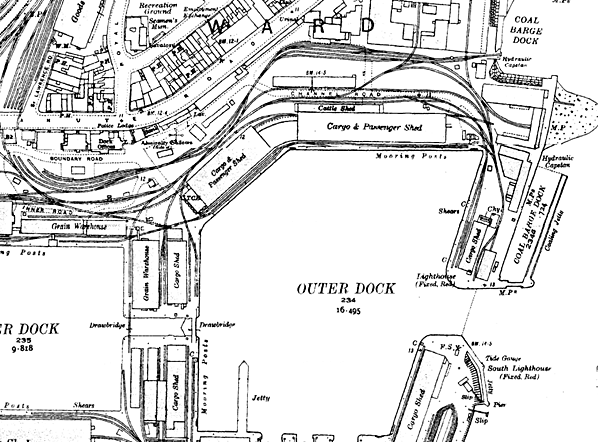 1933 1:2,500 OS map of Outer Dock
The transformation of leisure and sailing facilities, plus some very upmarket housing, did away with virtually everything – except the Continental Booking Office which still stands today as part of the Ocean Village complex. 4.jpg) The Continental Booking Office in March 2010. The building is now incorporated into the Ocean Village complex. Photo by Peter Trimming. Reproduced from Geograph under creative commons licence ITCHEN QUAYS
berths were, in part given over to car ferries
quays1.jpg)
The Itchen Quays berths 31 - 32 in 1934.
Photo from Bert Moody collection EMPRESS DOCK The Empress Dock was officially opened by Queen Victoria in July 1890 although some of the quayside sheds had yet to be completed by that date. It was then capable of taking the largest vessels afloat.
docks.jpg)
Empress Dock with the Royal Mail Lines vessel Atlantis at Berth No.26.The sheds across the bottom of the photo are berths 20/21.
Following the demise of the banana trade the berths were redeveloped as the Southampton Oceanography Centre which opened in April 1996 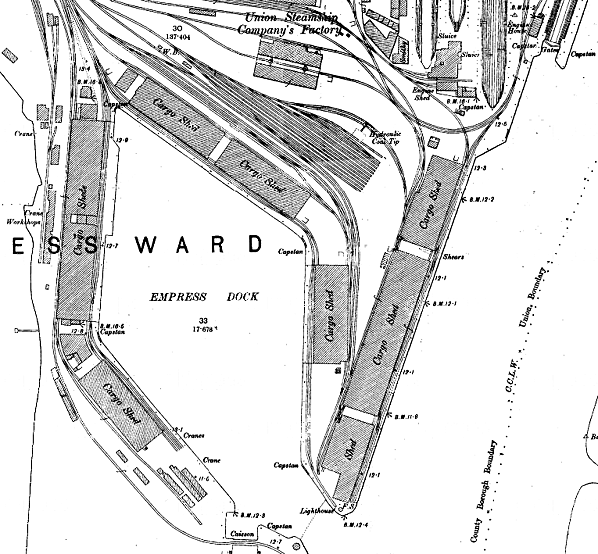 dock1.jpg) The northernmost point of the Empress Dock in the early 20th century looking north towards the main dock gate (now No.4). At centre right is the former coaling stage at berth 13 in the Inner Dock with warehouses at the top right. Beyond these is the South Western Hotel adjacent to the former Terminus Station to where the passenger train is headed.
Copyright photo from John Alsop collection OCEAN QUAY The Ocean Quay, initially named the Prince of Wales Quays, were constructed south of the entrance to the Empress Dock and were completed by August 1895 and numbered as berths 34-36 and became home to Union Castle vessels bringing imports of fruit, wool grain and animal skins from South Africa, as well as significant passenger numbers to and from the corner of the Empire. Trade was such that the quays were widened in from 1939 and reopened in 1940. While this work was in progress, Union Castle ships transferred their operations to the New (Western) Docks at berths 106 and after moving to berths 102-104, remained there afterwards. 1.jpg) Union Castle Quays at 34 berth in 1927.
Photo from Bert Moody collection 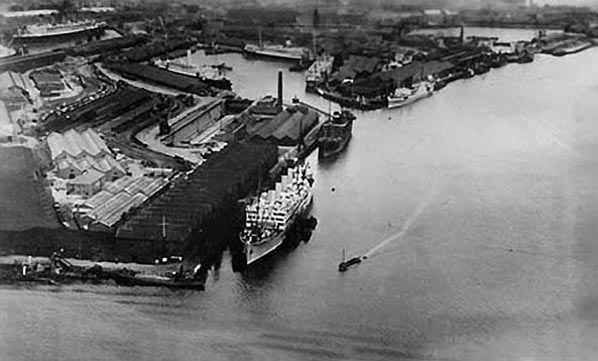 The four funnelled vessel is alongside berths 35/6 - the former Prince of Wales Quays (part of the Ocean Quays) along the River Itchen. The Empress Dock is the diamond shaped basin beyond it.
TEST QUAYS & QE II TERMINAL The South and Test Quays were the next extensions north and west along the River Test and completed by 1902. The South Quay (berth 37) was used by vessels of Rotterdam Lloyd and the Netherland Royal Mail lines, while Union Castle ran their continental steamer from that berth while the Test Quays, berths 38-41 were home to both passenger facilities and a huge cold store. The sheds at 38/9 were rebuilt as the Queen Elizabeth II Terminal which opened in July 1966 and became primarily the home base of Cunard’s QE2 and is still use by others today. 1.jpg) Queen Elizabeth II terminal at berths 38/9 in 1966
|



5.jpg)
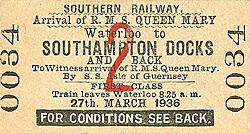
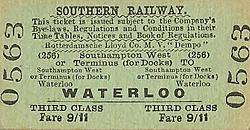
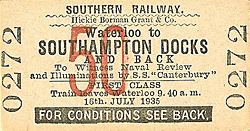

 Home Page
Home Page